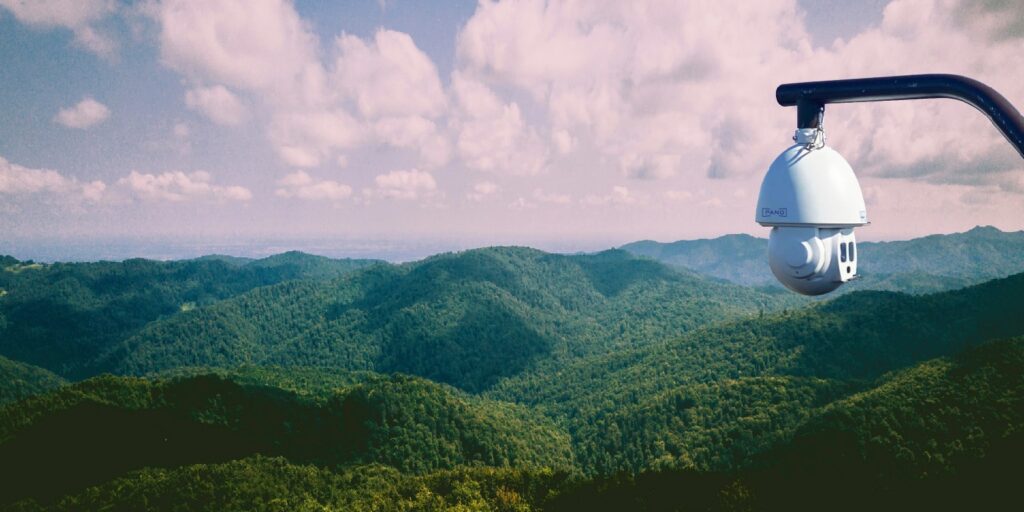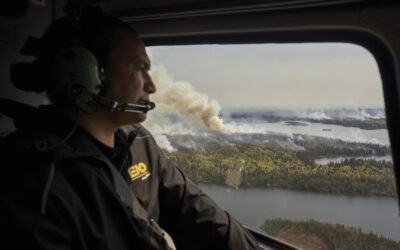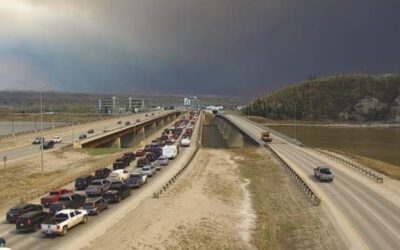
Photo: Pano AI/Facebook
The matter is, for now, rhetorical, as AI is still very new to wildland firefighting. Historically, however, the potential for human missteps is well-known.
HUMAN LIMITATIONS IN FIRE RESPONSE
It can be challenging for humans to make fully informed decisions when planning wildfire response.
In 2007, dispatchers initially dismissed 911 calls about smoke near Lake Tahoe, mistakenly believing it was a controlled burn. In reality, it was a wildfire that ultimately destroyed 254 homes and burned 3,100 acres of mountain wilderness.
Even if crews can accurately assess the threat of a fire, there’s no guarantee there will actually be people available to help.
The National Interagency Coordination Center (NICC), a central coordination hub for managing resources during wildfire incidents and other major disasters nationwide, allocates and mobilizes critical resources like firefighting crews, aircraft, equipment and specialized teams to wildfires and other major incidents across the country.
Throughout the years there’s been a consistent problem: there aren’t enough crews to keep up with requests. Nearly 3 in 10 requests NICC received in 2023 were “unable to be filled.” The lack of available crews means it’s critical that resources are dispatched where they’ll have the biggest impact.
Additionally, when crews are available to fight the fire, the human body can only handle so much in terrain more vast and rugged than a structure fire.
The U.S. Fire Administration tracks and collects information on the causes of on-duty firefighter fatalities that occur in the United States. A Government Technology analysis of the data revealed there’s been at least 346 on-duty deaths of firefighters and crew battling wildland, brush and grass fires since 1990.
The leading causes of death in wildfire responses weren’t burns or smoke inhalation, but heart attacks caused by stress and overexertion.
Many others have been killed attempting to scout out the location and conditions of fire in rugged terrain, like Curtis Jessen, a district forester in North Carolina who slipped and fell off a cliff while trying to determine if a brush fire in the area was no longer a threat.
COULD AI PROVIDE A SOLUTION?
Pano Station, Snowmass, CO
Pano AI
Pano AI, a company focused on the detection and mitigation of wildfires, believes technology can revolutionize the way wildfires are fought. It uses deep learning to detect the smoke of new fires, and high-powered cameras to get impactful video insight that allows agencies to build smarter response plans.
Pano AI has customers in nine states, including city, county, state and federal governments and private businesses.
Its product is a network of ultra-high-definition cameras stationed at high elevations and constantly rotating to provide a 360-degree view, paired with high-speed wireless connectivity, satellite feeds and cloud-based software.
“We use these feeds to detect the first signs of a new fire both day and night, and then we push out alerts that contain important situational awareness video feeds that allow first responders to make decisions in the early moments about the fire,” said Pano AI CEO Sonia Kastner.
The San Francisco-based company has had government clients in the United States for three full wildfire seasons and one of its first was the Aspen Fire Protection District in Colorado in 2021.
Fire’s challenge to AI is a complex one, Kastner said, but with each passing season, the technology gets smarter.
“Actually detecting fire is a pretty difficult machine learning problem to solve, because wildfires don’t happen very often. There are actually a lot of phenomena in the natural world that look similar to fire, and wildfires look a little bit different every time,” she said. “The model is getting better and better.”
WILL AI CHANGE WHAT HUMANS DO?
Pano AI has a 24/7 threat intelligence center, a team of human analysts who review alerts and time-lapse footage, dismissing false alerts like clouds before they alert their customers. Using the high-powered cameras, the analysts distinguish between smoke that may not need to be addressed immediately and incidents that will require a multiagency approach from the start.
“It allows the most severe fires to rise above the noise, and means that with agencies that have limited resources, those most risky incidents can be controlled quickly,” said Kastner.
One of Pano AI’s clients, the Washington State Department of Natural Resources, told Government Technology the technology supplements the work of humans, allowing employees to dedicate more time to other tasks.
“They can focus on the actual dispatching side of the job, rather than having to multitask — it keeps them focused on their job as a dispatcher, not so much intelligence gathering,” said DNR Assistant Division Manager of Plans and Information, Wildland Fire Management Division Angie Lane.
FUTURE OUTLOOK
Pano AI admits there is a big barrier to wide-scale deployment across the country: budget constraints.
A pilot program in Colorado’s Telluride Fire Protection District last year came with a $100,000 price tag. Pano AI charges customers about $50,000 per camera per year. Its CEO said funding should be higher-level — a process that is already under consideration.
“City budgets are tight and fundamentally, this solution, we believe, should be provided at the state and federal level,” Kastner said. “There’s been a lot of discussion and early efforts in Congress to fund this at the federal level for Forest Service land, for [Bureau of Land Management] BLM land. We would strongly advocate that funding needs to continue and this needs to be deployed broadly across federal Forest Service and BLM land through federal agencies.”
___
(c)2024 Government Technology
Visit Government Technology at www.govtech.com
Distributed by Tribune Content Agency, LLC.




